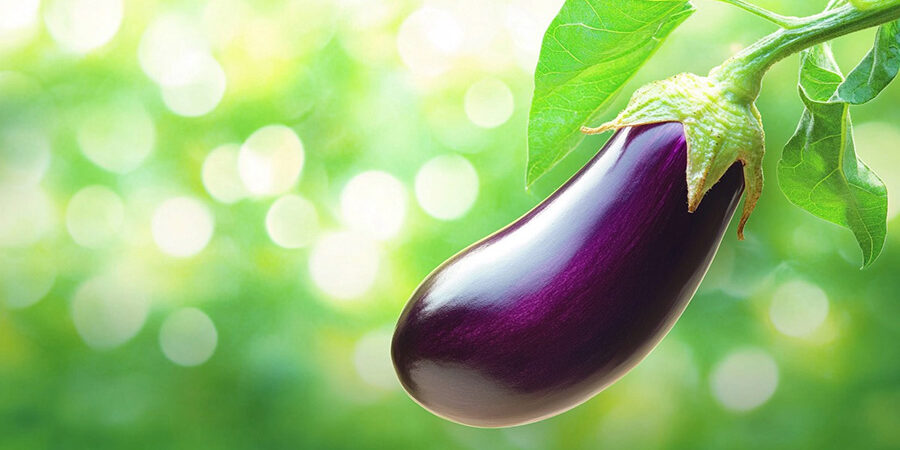With the support of our stable Hungarian producer base, this vegetable is always available in high quality in our wholesale assortment – ask us for an offer!
Aubergines, also known as eggplants (Solanum melongena), are one of the most versatile and versatile vegetables in the world of cooking. Although botanically considered a fruit, it is used as a vegetable in gastronomy. It originated in India, where it has been cultivated for thousands of years, and spread to Europe through Arab traders. In Hungary, aubergines became popular with the spread of Balkan and Mediterranean cuisine.
Aubergines are not only delicious, they are also healthy. It is low in calories but high in fibre and contains a significant amount of antioxidants, particularly a compound called nasunin, which can help protect cells. Its potassium, B vitamins and manganese can also contribute to a balanced diet.
Economically, aubergines are an important part of the vegetable production in Mediterranean countries. In Europe, Italy and Spain in particular are major producers. It is also cultivated in Hungary, mainly in greenhouses, as it is a heat-loving plant that does not tolerate cold.
Specificities of aubergine production
Aubergines are a heat-loving crop and are grown on a large scale in Europe, mainly in Mediterranean and southern European countries. Italy leads the European production ranking, followed by Spain and Greece. In Hungary, it is grown on a small scale, mainly under glasshouses, as the climate in the country does not provide ideal conditions for outdoor cultivation.
The aubergine season in our country lasts from around June to the end of September. During the rest of the year – especially in winter and early spring – aubergines are mainly imported, mainly from Spain and Italy.
How to choose good quality aubergines?
To choose a good quality aubergine, you should consider the following points:
- The skin should be shiny, smooth, firm and dark purple in colour. A dull, wrinkled or damaged skin indicates ageing or over-ripening.
- The whole vegetable should be firm to the touch but slightly elastic. Too soft specimens may be wilted and overripe specimens may taste bitter.
- The stem should be fresh green, not dry or brownish.
- Avoid pieces that are too large, as these often have a spongy consistency and contain a lot of seeds.
How to use aubergines in the kitchen?
Aubergines are a true kitchen chameleon, as they can be prepared in a multitude of ways:
- You can roast them whole or in slices – grilled aubergine slices make a great side dish or salad base.
- Excellent as a stuffed dish: cut in half and hollowed out, aubergines can be fried with meat, rice or vegetables.
- It can be prepared as an aubergine cream (e.g. Transylvanian or Middle Eastern style), spread on toast or as a dip.
- It is the main ingredient in important Mediterranean dishes, such as Greek muscovy, French ratatouille and Italian parmigiana di melanzane.
- It pairs well with tomatoes, garlic, olive oil and basil, so it also works well in vegetarian dishes.
It is important to note that aubergines should not be eaten raw as they can be bitter and the solanine they contain can be mildly toxic in large quantities. Always heat-treat!
How to store aubergines?
It is not advisable to store aubergines for long periods, as they lose their freshness quickly. For proper storage, the following points should be observed:
- It will keep at room temperature for 1-2 days if the room is not too hot.
- It can be stored in the refrigerator for up to 4-5 days, but preferably in the vegetable storage compartment, loosely wrapped.
- Avoid storing in wet or plastic bags, as these can speed up spoilage.
- Eggplants should not be frozen raw, but they are suitable for freezing when pre-cooked or grilled.
Interesting facts about aubergines
- Its name comes from the Persian word “bâdenjân”, from where it was translated into Arabic, then into Latin and Hungarian.
- For a long time in the Middle Ages, it was treated with suspicion in Europe and was thought to cause madness – hence one of its contemporary names: ‘the apple of madmen’.
- The English name ‘eggplant’ refers to the fact that some early varieties produced small white egg-shaped fruits.
- It has a history of thousands of years of cultivation in China and India, and was even used in ancient Chinese medicine for medicinal purposes.
Tips for using aubergines in the kitchen
- Soaking aubergines in salted water or salting them after slicing can reduce their bitterness and water content, so they absorb less oil when cooking.
- For grilling or frying, it’s best to cut into thicker slices to prevent it drying out too quickly.
- When making aubergine cream, it’s a good idea to remove the skin as it can be bitter – this is easiest done after frying.
- If you make a stuffed dish, don’t throw out the hollowed-out insides: they make an excellent base for other dishes or for lecsó, for example.
- It can also be used as a meat substitute in vegetarian dishes: its characteristic texture and flavour make it a good accompaniment to main courses.


